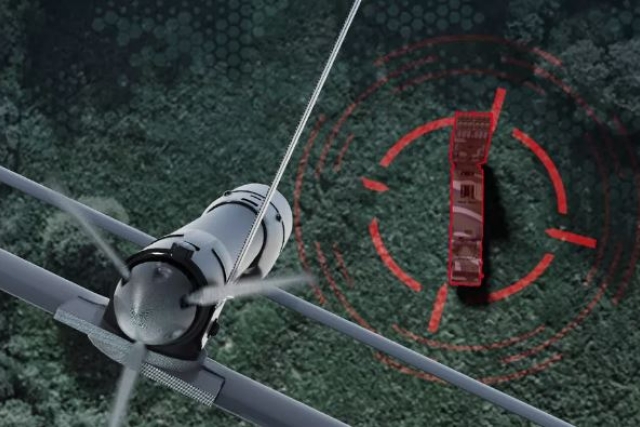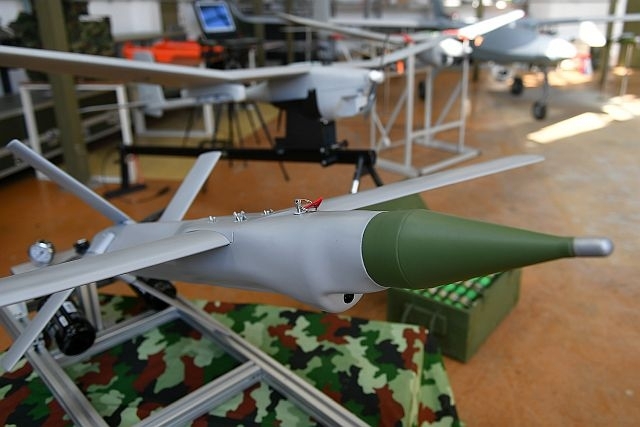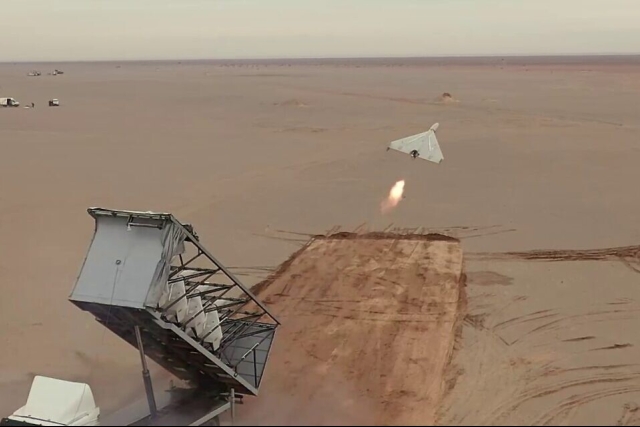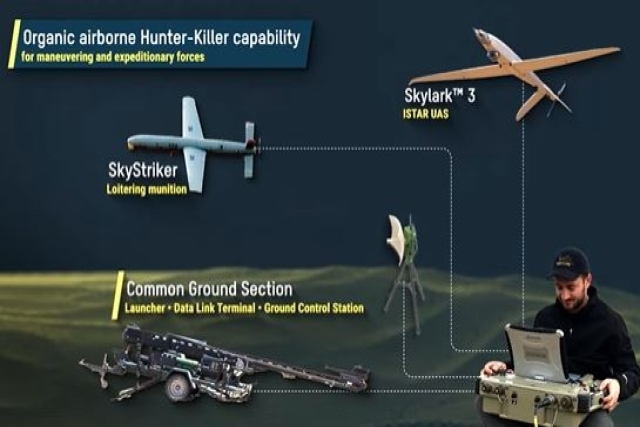Precision in the Skies: The Evolution of Loitering Munitions
Hovering drones redefine combat tactics, from targeted hits to armored vehicle defense in tight spaces.

Switchblade 600
Loitering munitions - drones that hover over a target and blow up near it - have become the weapon of choice in targeted assassinations and to counter tanks and armored vehicles in congested environments.
Early loitering munitions were of the launch-and-forget type where operators would launch them only where were sure of their target’s presence such as the Israeli Aerospace Industries’ Harpy. The Israeli Air Force (IAF) can be considered the pioneer in the usage of loitering munitions by using them to provide real-time targeting links to IAF warplanes to neutralize Syrian air defenses in the 1982 Lebanon War.
Latest innovations include mid-course correction and precise targeting in congested environments, integrating intelligence, surveillance, and reconnaissance functions. Recovery of re-use in case a mission is aborted.
A few of the recent developments in loitering munitions are enumerated below:
Teledyne FLIR: Rogue-1
Teledyne FLIR Defense debuted its latest advancement, the Rogue 1 loitering munition system, at the Special Operations Forces (SOF) convention in Tampa during May 2024. The Rogue 1 distinguishes itself as a rapidly deployable vertical takeoff and landing (VTOL) small unmanned aerial system (sUAS), allowing warfighters to execute precision-strikes against both moving and stationary targets. A notable feature is its advanced fuzing system, incorporating a unique mechanical interrupt for safe recovery and reusability when missions are aborted or targets disengaged.
Equipped with advanced electro-optical and FLIR Boson 640+ thermal cameras, the Rogue 1 enables day and night long-range reconnaissance and surveillance with its gimballed payload system, enhancing precise targeting through sensor integration with the warhead. Its mission-specific payloads include Explosively Formed Penetrator (EFP)and Forward Fragmenting.
With a flight time of 30 minutes, speeds exceeding 70 mph (113 kph), and a range of over six miles (10 km), the Rogue 1 is designed to endure harsh battlefield conditions, including environments with communication and GPS denial. Teledyne FLIR Defense's introduction of the Rogue 1 follows its selection by the U.S. Marine Corps for an Indefinite Delivery/Indefinite Quantity contract worth up to $249 million under the Organic Precision Fires-Light (OPF-L) program.
AeroVironment: Switchblade
The Switchblade munitions comes in two models- 300 and 600 both of which have been donated to Ukraine by the U.S. While the Switchblade 300 targeted soft targets, the 600 was designed for heavy armor. Effectiveness depends on delivery and advantages over improvised munitions in range, accuracy, and jamming resistance. Jamming caused significant drone losses, with Ukraine losing 10,000 drones monthly due to Russian interference. AeroVironment improved the Switchblade 600's jamming resistance through software updates and better training.
Anduril Industries: ALTIUS-700M
Anduril Industries concludes testing for its ALTIUS-700M loitering munition at Dugway Proving Grounds in March 2024. The drone demonstrated precision hits in September 2023, marking the first live warhead assessment. With a payload capacity comparable to an AGM-114 Hellfire missile, the ALTIUS-700M offers extended range and loitering time, controlled by a single operator.
Serbia's Mosquito
Serbia plans to manufacture 5,000 kamikaze drones, including the "Mosquito," with warheads. The mosquito drones are said to feature an aerodynamic body to aid their quick flight to the target. They can loiter and be called back to base if the target is not acquired within their endurance time.

Zala Aero: Product-55 (Izedeliye 55)
Russia’s Zala Aero Group announced the launch of its latest innovation, the Product 55 loitering munition in January 2024. Featuring a distinct X-wing aerodynamic design inspired by the Lancet family, the Product 55 is equipped with four engines and is designed for short-range operations. The system enables real-time monitoring in Full HD quality, allowing operators to optimize the angle of approach to the target. the munition is claimed to be resilient against enemy electronic warfare systems.
Zala Aero: Lancet
The ZALA Lancet loitering munition has been extensively used in the ongoing Ukraine war. In February 2024, Manufacturer ZALA Group announced a fifty-fold increase in the production of high-precision weaponry coinciding with the commencement of the Special Military Operation in Ukraine.
In September 2023, a Ukrainian MiG-29 fighter suffered damage after being hit by a Lancet.
The ZALA Lancet It has undergone combat testing in Syria during the Russian military intervention in the Syrian civil war and has also been deployed during the ongoing Russian invasion of Ukraine.
Israel Aerospace Industries: Harpy NG
As a loitering munition system dedicated to the suppression and destruction of enemy air defenses (SEAD/DEAD), Israel Aerospace Industries’ (IAI) HARPY provides a strategic tool for armed forces planning a strike against anti-access/area denial (A2AD) defensive systems. HARPY is launched from Ground-Based or Naval Canisters and endures long ranges, paving a safe corridor inside enemy airspace.
Equipped with an Anti-Radiation (AR) seeker, HARPY can autonomously seek and strike emitting, high-value targets. The HARPY operates in deep strike missions lasting up to 9 hours, and in GNSS-denied or contested battlefields. HARPY is equipped to hunt—seek targets in a designated area, locate and identify their frequency, and autonomously pursue a strike from any direction, at shallow or steep dive profiles.
Israel Aerospace Industries: Harop
Israel Aerospace Industries’ (IAI) HAROP is a standoff loitering attack weapon system that combines features of both a UAV and a missile. HAROP can identify targets without prior intelligence and plan precise attack routes. It has a 9-hour endurance and is resilient against GNSS jamming and can be supervised remotely, with the flexibility to abort missions if necessary. It is easily deployable from trucks or naval vessels.
In April 2016, Azerbaijan deployed IAI Harop drones in the Nagorno-Karabakh conflict, targeting Armenian soldiers' buses and a command post. Criticism arose in April 2018 over Israeli arms supply to Azerbaijan when IAI systems, including the Harop, were showcased in an Azerbaijan Army film. In May 2018, the Israeli Defense Forces Harop destroyed a Syrian Air Defense SA-22 Greyhound air defense system. The Harop was also used by the Azerbaijan Air Force in the 2020 Nagorno-Karabakh conflict, earning praise for its effectiveness from Azerbaijani President Ilham Aliyev's advisor, Hikmet Hajiyev.
Iranian loitering munitions
In October 2023, the Iranian Army revealed two new loitering munitions, Sina and Fateh, during the Eqtedar 1402 military drills. These kamikaze drones, armed with 300 to 1,000-gram warheads, successfully hit designated targets within a 10-kilometer radius. Ababil-4 drones also demonstrated precision by dropping Qaem-5 bombs on targets from a 7-kilometer range. The Mohajer 6 drone carried out a successful offensive operation in Nasrabad, Isfahan, using laser-guided missiles.
Iran is also developing Lancet-like kamikaze drone for widespread use in counter-ambush operations.
There are a few drones that have doubled up in their function and have been used as loitering munitions.

Android Technics: BAS-80
Russian engineers are developing the BAS-80 loitering munition, a drone inspired by the American Switchblade model. Evgeniy Dudorov, general director of SPA "Android Technics," released videos and images of the BAS-80, revealing that some units have already been deployed for field testing in Ukraine. The footage shows the drone's launch mechanism, which uses a powder charge to deploy it from a transport container.
The BAS-80, weighing 1.7 kilograms and made from composite materials and fiberglass has a payload capacity of 500 grams, extendable to 2 kilograms. It operates with an electric motor, covers up to 30 kilometers, reaches speeds of 130 km/h, and can maintain altitudes up to 200 meters.
Detailed images showcase the drone’s optical system with three lenses for color and infrared imaging. The BAS-80's specifications surpass those of the American Switchblade 300, which has a shorter range and smaller payload.
Elbit Systems: SkyStriker
Elbit Systems announced it was supplying 'several hundred' SkyStriker loitering munitions (LM) to a European country in September 2023.
The SkyStriker LM is a fully autonomous loitering munition that can locate, acquire and engage operator designated targets with a warhead of up to 10 Kg, enabling high-precision performance. SkyStriker can be launched from a variety of ground and aerial platforms, including from a dedicated canister on Elbit Systems’ PULS (Precise and Universal Launching System) rocket artillery.
Equipped with an electrical engine, the SkyStriker enables covert operations of up to 2 hours with a range of 100km. The system can precisely strike targets while maintaining a “man in the loop” even in GPS and communication denied environments. The Skystriker can use a number of warhead types which can be interchanged in the field during pre-flight according to the operational requirement.
Mac Jee: ANSHAR
Brazilian firm Mac Jee introduced its explosive drone prototype, ANSHAR, at Dubai Air Show - 2023. According to the company, the loitering munition boasts speed of 170 m/s, a minimum altitude of 10 meters (sea skimming), a range capacity of 180 km, and one hour of flight autonomy. These features enable the explosive drone to effectively target both land and sea objects. Mac Jee plans to officially launch the ANSHAR in early 2025, anticipating its success on the international market.
Elbit Systems’ FAST Capsule Integrating Skylark III UAS and SkyStriker LM
Elbit Systems has introduced the Find-and-Strike (FAST) Capsule, which combines the Skylark III UAS and SkyStriker Loitering Munition (LM). The Skylark III, a small-tactical intelligence UAS, features advanced sensors and up to 18 hours of endurance, supporting ISTAR missions in GPS-denied environments. It can carry various payloads, including high-resolution cameras and SIGINT sensors.
The SkyStriker LM is an autonomous munition capable of high-precision strikes with a 10 kg warhead, operable for up to 2 hours within a 100 km range. It can be launched from ground and aerial platforms and remains effective in GPS and communication-denied settings.

Some prominent loitering munitions
|
|
Rogue-1 |
Switchblade 600 |
ALTIUS-700M |
Product 55 |
Harpy NG |
Harop |
Lancet-3 |
|
Manufacturer |
Teledyne FLIR |
AeroVironment |
Anduril Industries |
ZALA Aero Group |
Israel Aerospace Industries |
Israel Aerospace Industries |
ZALA Aero Group |
|
Operational status |
Unveiled in May 2024 |
Operational |
Testing ongoing |
Unveiled in January 2024 |
Operational |
Operational |
Operational |
|
Functions |
Precision-strikes, reconnaissance, and surveillance missions |
Reconnaissance, surveillance, and target acquisition (RSTA) support |
Missions ranging from intelligence gathering to kinetic strikes. |
- |
Anti-radiation drone and loitering weapon Optimized for the SEAD operations |
Loiter above the battlefield and attack targets by crashing into them and exploding |
Reconnaissance and strike |
|
Speed |
70 mph 113 kph
|
Loiter: 70 mph (113 km/h) Sprint: 115 mph (185 km/h) |
- |
- |
>370 km/h |
225 km/h |
80-110 km/h |
|
Endurance |
30 minutes |
40+ minutes |
75 minutes |
|
6 hours |
9 hours |
40 minutes |
|
Range |
6 miles 10 km |
40+ km |
160 km |
50 km |
>100 km |
200 km |
40 km |
|
Payload Options |
Explosively Formed Penetrator (EFP), Forward Fragmenting, or non-lethal Trainer options |
Munition: 33 lb (15 kg)
Small explosive, armor-piercing payload meant for small arms and personnel attacks |
Munition payload capacity of up to 33 pounds (15 kg) |
Warhead weight- 5 kg |
Warhead weight- 15 kg |
Onboard explosive of 23kg (51lb); electro-optical and infrared seeker; anti-radar homing system; forward-looking infrared (FLIR) and colour charge-coupled device (CCD) camera. |
MTOW: 12 kg High explosive (HE) or HE-fragmentation warheads. |
|
Sensors |
Gimballed payload system ensures precise targeting by coupling advanced sensors with the warhead |
Target acquisition sensor suite and mission planning on a tablet controller |
- |
Optoelectronic module transmitting Full HD quality images in real-time |
- |
Electro-optic seeker to identify targets without prior intelligence |
Optical-electronic and TV guidance systems Intelligence, navigation and communications modules |
|
Unique features |
Optionally-lethal VTOL sUAS |
Less than 10 minutes system setup & launch Tank Busting Performance |
High terminal velocity and optional delayed fuze payload configurations, allowing it to penetrate target walls effectively |
Distinctive X-wing aerodynamic design derived from the Lancet family Four engines Remote container launch capabilities Resistant to EW, jamming Operator can choose the optimal approach angle to the target |
“Fire and forget” autonomous weapon |
Deployable from trucks or naval vessels |
Can be used in an "air mining" role by diving up to 300 km/h (190 mph) to strike enemy UCAVs mid-flight
|
|
Deployment in wars |
- |
Ukraine War |
- |
- |
- |
Nagorno-Karabakh |
Syrian War Ukraine War |









